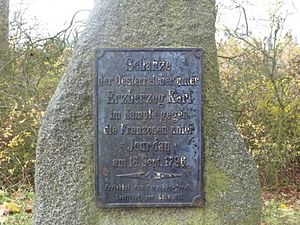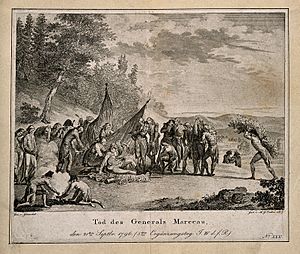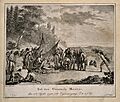Battle of Limburg (1796) facts for kids
Quick facts for kids Battle of Limburg |
|||||||
|---|---|---|---|---|---|---|---|
| Part of the War of the First Coalition | |||||||
 Marker indicating the location of the Austrian line |
|||||||
|
|||||||
| Belligerents | |||||||
| Commanders and leaders | |||||||
| Units involved | |||||||
| Army of Sambre-et-Meuse | Army of the Lower Rhine | ||||||
| Strength | |||||||
| 45,000 | 20,000 | ||||||
The Battle of Limburg, also known as the Second Battle of Altenkirchen or Battle of the Lahn, took place from September 16 to 19, 1796. It was a key event during the War of the First Coalition, which was part of the larger French Revolutionary Wars. The battle happened near Limburg an der Lahn in Germany.
On September 16, the Austrian army, led by Archduke Charles, Duke of Teschen, attacked the French army. The French forces were commanded by Jean-Baptiste Jourdan and were positioned behind the Lahn River. The French right side unexpectedly fell back, forcing them to retreat over the next three days. This fighting retreat lasted until September 19.
Earlier in the year, two French armies had pushed deep into southern Germany. However, Archduke Charles defeated Jourdan's army at Amberg and Würzburg. This forced the French to pull back to the Lahn River. During the Battle of Limburg, Charles attacked the French at Giessen and Limburg. Even though the Austrian attacks faced strong resistance, Jourdan had to retreat. This was because his right flank commander, Jean Castelbert de Castelverd, ordered his troops to fall back.
Over the next three days, French generals François Séverin Marceau-Desgraviers and Jean Baptiste Bernadotte led a fighting retreat. They moved back to Altenkirchen to allow Jourdan's other troops to escape. Sadly, French division commanders Marceau and Jacques Philippe Bonnaud were badly wounded and later died in these clashes. After the battle, Jourdan moved most of his army to the west bank of the Rhine River. This effectively ended the fighting in the northern part of the campaign. Archduke Charles then left a smaller force to watch the French and moved south to try and stop another French army.
Contents
Why This Battle Happened
The Rhine Campaign of 1796
The fighting in the Rhine Campaign of 1795 ended with a truce in January 1796. This agreement lasted until May 20, 1796, when the Austrians announced it would end.
The Austrian army, called the Coalition Army of the Lower Rhine, had about 90,000 soldiers. A part of this army, about 20,000 men, was on the east side of the Rhine River. They were watching the French position at Düsseldorf. Other Austrian forces were stationed near Mainz Fortress and Ehrenbreitstein Fortress. The rest of the Austrian army was on the west bank of the Rhine. Another large Austrian army, the Army of the Upper Rhine, had 80,000 soldiers.
The French had their own plans. Their Army of Sambre-et-Meuse had 80,000 soldiers. Another French army, the Army of Rhin-et-Moselle, was positioned further south.
French and Austrian Plans
The French had a big plan: two of their armies would push into Germany from the north. At the same time, a third army would move towards Vienna through Italy. Jourdan's army was supposed to move southeast from Düsseldorf. This would hopefully draw Austrian troops away, making it easier for Moreau's army to cross the Rhine.
Jourdan's army pretended to attack Mannheim, and Archduke Charles quickly moved his troops to respond. Meanwhile, Moreau's army attacked a bridgehead at Kehl. This position was defended by 7,000 inexperienced German troops. Moreau's forces eventually broke through and moved into Baden. Another French column also crossed the river further south.
Archduke Charles became worried about his supply lines being stretched too thin. So, he began to retreat eastward.
Turning the Tide
At this point, the French generals didn't work together as well as they could have. Moreau could have joined Jourdan's army, but he didn't. Instead, he kept moving east, pushing Charles further into Bavaria. Jourdan also moved east. If the French armies had joined forces, they might have crushed the Austrians.
However, the Austrians united first. Archduke Charles joined his forces with another Austrian general, Wartensleben. This changed the course of the campaign. Charles's victories against Jourdan's army at Amberg, Würzburg, and then Limburg, allowed him to send more troops to the south.
Where the Battle Took Place
Limburg an der Lahn was an important city in the region during the early 1800s. It is located between the Westerwald and Taunus mountains. The city is surrounded by slate mountains to the east and the Lahn River. This area was very good for farming.
Limburg's location on the Lahn River made it a key spot for travel and trade since the Middle Ages. The Lahn River valley widens noticeably around Limburg. The city is about 384 feet (117 meters) above sea level.
Armies Get Ready
By early September, Archduke Charles had defeated Jourdan's army at Amberg and Würzburg. The French had retreated about 221 kilometers (137 miles) northwest, reaching the Lahn River by September 9. Jourdan's army had about 25,000 infantry, 5,000 cavalry, and 6 artillery batteries.
Here, Jourdan's army was joined by 16,000 fresh troops led by General François Séverin Marceau-Desgraviers. Marceau had been blocking Mainz but now joined Jourdan. With more soldiers, Jourdan decided to defend the Lahn River line. He hoped to keep the Archduke's army busy and stop them from moving south to attack Jean Victor Moreau's army.
Archduke Charles arrived at the Lahn on September 11. His strong pursuit stopped the French from going south to join Moreau. Charles saw that Jourdan had a good defensive position and more soldiers. So, he decided to fake an attack on the French left side, near Giessen and Wetzlar. His real attack would be on the French right side.
To do this, Charles ordered his generals, Paul Kray and Anton Sztaray, to make a lot of noise and confusion. This made Jourdan believe the main Austrian attack would come from his left. By September 15, the French had moved most of their forces to their left. Marceau was positioned between the Rhine and Limburg, with his advance troops southeast of the city. Bernadotte was to the east, and Championnet was further northeast.
Jourdan's troops were on the eastern bank of the Rhine. Moreau, who was much further south, could not help Jourdan, nor could Jourdan help Moreau.
The Battle Begins
On the morning of September 16, Archduke Charles pushed Marceau's outposts out of Mensfelden. He then captured Diez and Limburg. Marceau still controlled the part of Limburg on the north bank of the Lahn River. The Archduke brought up his cannons, captured the Limburg Bridge, and forced Marceau and his men out of the suburb.
Marceau managed to stop the Austrian army from moving any further, and the Austrian attack stalled. The French then counterattacked and pushed the Austrians back across the Lahn. The suburb changed hands two more times that day. But when night came, it was back in French control.
During the night, the Archduke prepared for a new attack across the Lahn. He planned to use four columns and more soldiers than the day before. Marceau also prepared to fight. However, to his right, General Jean Castelbert de Castelverd panicked. He was worried that an Austrian breakthrough at Limburg would trap his troops against the Rhine. So, he pulled his soldiers back to Montabauer.
This retreat left Marceau's right side open, so he also had to pull his troops back to Molsberg. Marceau's retreat then exposed the French center, which also had to withdraw. By the end of September 17, the entire French line had fallen apart.

Second Battle of Altenkirchen
As Jourdan's army retreated from Limburg, Marceau's troops acted as the rearguard. They held off the main Austrian army long enough for the French center and left to reach Altenkirchen. On September 18, the French continued their general retreat around Molsberg and Freilingen. Marceau was ordered to fight a delaying action. This would give the French left wing time to catch up with the center, which had already reached Höhn and Schönberg.
Marceau stayed near Molsberg all day. When he learned that the main army had started to pass through Altenkirchen, he began his own retreat. However, he arrived at the northern edge of the Höchstenbach before all of Grenier's and Championnet's divisions had passed through the town. Jourdan ordered Marceau to make a stand at Altenkirchen to ensure these divisions could get through safely.
Marceau led the main part of his division back to support the rearguard. But while he was checking the Austrian positions, he was shot and badly wounded. Marceau's shocked troops managed to hold on long enough to prevent the Austrians from breaking the army apart. Realizing the French had escaped, Charles camped for the night at Freilingen. Charles had almost succeeded in breaking Jourdan's army. He had succeeded in stopping Jourdan from joining Moreau.
What Happened Next
Marceau, badly injured, stayed in Altenkirchen. Several Austrian officers visited him, including Paul Kray. Marceau died two days later, on September 21, just before Archduke Charles arrived to pay his respects. On September 23, the Austrians gave Marceau's body to the French at Neuwied, and he was buried in Coblenz. Both sides fired gun salutes to honor him. Jacques Philippe Bonnaud was also killed during the rearguard action.
The French army retreated further north, to the Sieg River. Charles left a small force, led by Franz von Werneck, at Altenkirchen to keep the French contained. He then turned south to deal with Moreau and his army. The next major clash happened on October 19 at Emmendingen.
Images for kids







